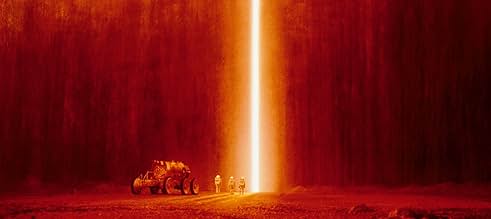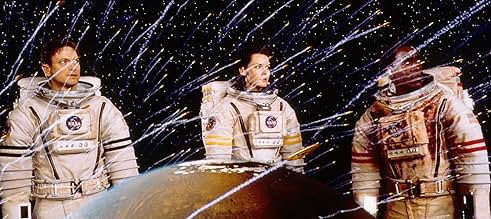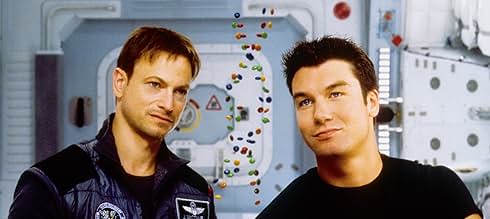Trotz minutiöser Vorbereitung und schärfster Sicherheitsvorkehrungen mündet die erste Mars-Mission in eine Katastrophe. Nun soll ein Rettungsteam nch möglichen Überlebenden und den genauen U... Alles lesenTrotz minutiöser Vorbereitung und schärfster Sicherheitsvorkehrungen mündet die erste Mars-Mission in eine Katastrophe. Nun soll ein Rettungsteam nch möglichen Überlebenden und den genauen Ursachen des Desasters suchen. Mit an Bord sind die NASA-Astronauten Woody Blake und Jim Mc... Alles lesenTrotz minutiöser Vorbereitung und schärfster Sicherheitsvorkehrungen mündet die erste Mars-Mission in eine Katastrophe. Nun soll ein Rettungsteam nch möglichen Überlebenden und den genauen Ursachen des Desasters suchen. Mit an Bord sind die NASA-Astronauten Woody Blake und Jim McConnell.
- Auszeichnungen
- 3 Nominierungen insgesamt
- Child at Party
- (as Jeff Ballard)
Handlung
WUSSTEST DU SCHON:
- WissenswertesThe filmmakers created the Martian landscape in a massive sandpit near Vancouver. It was one of the biggest sets ever constructed for a movie - around two million square feet.
- Patzer(at around 1h 18 mins) While looking at a DNA sequence Terri Fisher says that the last two chromosomes are missing. What is missing is actually the last two nucleotides of the sequence. DNA does not have chromosomes. Rather, chromosomes are comprised of DNA, and a single chromosome will contain many tens or hundreds of millions of nucleotides.
- Zitate
Terri Fisher: The genetic difference between men and apes is only three percent. But that three percent gave us Einstein, Mozart...
Phil Ohlmyer: ...Jack The Ripper.
- Crazy CreditsThe National Aeronautics and Space Administration's cooperation and assistance does not reflect an endorsement of the contents of the film or the treatment of the characters depicted therein.
- VerbindungenFeatured in Late Night with Conan O'Brien: Lisa Rinna (2000)
- SoundtracksMa 'Tit Fille
Written by Buckwheat Zydeco (as Stanley Dural, Jr.)
Performed by Buckwheat Zydeco
Courtesy of The Island Def Jam Music Group
By arrangement with Universal Music Special Markets
"Mission to Mars" introduces its playful intentions with its very first shot. A toy rocket, accompanied by carnival music, shoots up into the air and explodes. De Palma is here to play with his toys. The very next scene is an overly elaborate long-take in which all the film's characters, their loves and losses, are introduced.
As a formalist, De Palma often calls attention to the artificiality of art. Here he has two astronauts holding video cameras as a CGI beast veers toward them. We focus on Don Cheadle's eyes as he watches these two film-makers, the word "synthetic" stencilled in bold letters behind him. This whole action scene is fake, created for the audience. De Palma wants you to focus not on story, but the design and look of the thing. Likewise, the aliens at the end of the film are themselves artists who've designed man. As such, they demonstrate this knowledge to their audience (the astronauts) with a "film".
De Palma once said that space travel and scientific conquest are the only things that he can generate genuine optimism for, and one feels this in "Mission to Mars". The film has an overwhelming sense of earnestness. De Palma characters have never seemed so pure, optimistic, good natured and filled with humanity. There's no cynicism or bitterness here. Upon first viewing I found this all very cheesy, but now, coupled with Ennio Moricone's sweeping and romantic score, I find the film's broad brushstrokes very moving.
"Mission" also continues De Palma's trend of turning classic films on their side. He's done this to Hitch, Fellini, Anotonioni and Hawks. Now he does it to Kubrick (one scene literally has "2001: A Space Odyssey's" monolith on it's side).
Does this make De Palma a hack? No, It makes him a giddy delight if you're a film fan. "Mission to Mars" is a bit more straightforward than "2001," it's a little friendlier, but it's practically the same movie. Just replace the monolith with the "Mars face," and drop Hal. Both films' spaceships also look alike, and the white room used in the climactic scene strongly resembles the room at the end of "2001." And of course, where Kubrick gave us spaceships dancing the waltz, De Palma gives us astronauts dancing in zero gravity.
But De Palma doesn't stop at Kubrick. His film has a character named Luke who spends one scene talking about a mysterious "force" (Star Wars), a spaceship commanded by a man named Jim (Star Trek), and many overt reference to "Flash Gordon", "Robinson Crusoe" and "Teasure Island". Noticing that his tale is a virtual rehash of "The Abyss", De Palma also tips his hat to James Cameron by having Gary Sinese become submerged in oxygenated water (like Ed Harriss) during the film's finale. And of course both films have a CGI tentacle. Cameron gives us water, De Palma gives us sand.
Everything De Palma touches has been covered before. He acknowledges this. But it's how he touches, that's magical. His entire film is elegant and fluid. Every shot is just a little bit wider or closer than usual. His camera pans and tracks with robotic precision, dancing, points of views shifting, perspectives changing. There's a perfection in his form. Every shot is beautifully precise.
But what about the trite story, critics say? Yes, the story is silly, stupid even, but it's all told with such an earnest "awww shucks" feeling that it sucks you in. And besides, De Palma is never about story. Compare "Femme Fatale" to "Double Indemnity". "Compare Vertigo" to "Body Double" or "Obsession". He takes the core ideas of all these films and multiplies them by ten. You want "Double Indemnity"? De Palma gives you triple indemnity. You want Hitchcockian voyeurs? Hell, De Plama's voyeurs are watching voyeurs who themselves are being watched by even more voyeurs. You want illicit Hitchcockian affairs? Screw that. De Palma gives you Vertigo with incest. You want a slow-mo Hitchcock knife stab? Hell, De Palma kills you with a power drill and chainsaw.
Nothing in De Palma's cinema is real. He knows that all films are about other films. Everything he's done has been done before. This is what all formalists (Coens, Tarantino, Leone) are about. They're interested in the act of watching and how we catalogue what we see.
After 4 viewings, the only flaw I see in "Mission to Mars" is the film's unimaginative ending. Someone concerned with style and superficial form really should design a more imaginative ending. De Palma's silly alien hologram feels hokey, though Morricone's score does lend it an emotional sweep.
But this fault, I think, can be blamed on Touchstone. The studios had an 80 million dollar budget on the line, and weren't happy with where the film was going. They wrongly thought they had another Appolo 13/Gary Sinese rescue movie on their hands. And so looking to save cash, they chopped the budget and gave De Palma several months less to shoot the final act. Hence the film goes nowhere after the EVA sequence. But this sort of studio meddling is typical with De Palma (Snake Eyes, Mission Impossible, Casualties, Dahlia, Obsession, Bonfire etc were all taken away at some point).
8.5/10- The film has aged well. Gorgeous visuals, beautiful music and an affecting sense of optimism. The only flaw is the last act, which still works thanks to Morricone's score and an emotional flashback montage. Requires several viewings.
Top-Auswahl
Details
- Erscheinungsdatum
- Herkunftsländer
- Offizieller Standort
- Sprache
- Auch bekannt als
- M2M
- Drehorte
- Produktionsfirmen
- Weitere beteiligte Unternehmen bei IMDbPro anzeigen
Box Office
- Budget
- 100.000.000 $ (geschätzt)
- Bruttoertrag in den USA und Kanada
- 60.883.407 $
- Eröffnungswochenende in den USA und in Kanada
- 22.855.247 $
- 12. März 2000
- Weltweiter Bruttoertrag
- 110.983.407 $
- Laufzeit1 Stunde 54 Minuten
- Farbe
- Sound-Mix
- Seitenverhältnis
- 2.39:1
- 2.35 : 1
Zu dieser Seite beitragen

































